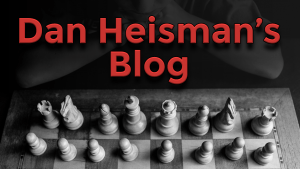"Final Answer": Determining When To Make Your Move
On the TV show "Who Wants to Be a Millionaire" the contestant lets it be known that he wants to stick with his answer by stating "Final answer!"
Similarly, an over-the-board chess player commits when he intentionally touches a piece (have to move it), releases it (must leave it on that square), and then presses the clock (completes the move).
However, when I began giving phone/internet lessons many years ago, I did not at first realize that I needed something similar when presenting puzzles to my students.
What happened was that I would ask a question such as "What move would you play in this position?" and, after some thought (hopefully! ), the student would respond something like:
), the student would respond something like:
"I think the move is Nd4."
However, even if I waited for silence after their reply, when I began to explain whether the answer was correct or incorrect, I often heard either:
- "Wait! I wasn't finished..." or
- "Wait! Now I see something else; I want to change my answer."
So, eventually I decided I needed a signal to determine:
- when the student was finished and willing to defend his/her answer, and
- when it was proper for me to speak.
Then it hit me that knowing when to make this signal was almost identical to a very important skill: the ability to know when to stop thinking and hit the clock! 
From that point the step to borrowing from the TV show was small. So, before I gave a new student their first puzzle, I instructed them:
- Treat the puzzle like you are playing a long time-control game; I don't want a quick answer unless you are sure would make a move in that amount of time, too,
- When you are sure you have the answer you want to defend, give me the answer and state "Final answer!" ("Hit clock" or "Push clock" work just as well), and
- After that you can't change your answer and have to defend it, just as you would if you pushed the clock in a real game.
Using this device killed two birds with one stone: not only did I now know when my student was finished, but simultaneously my student was practicing the important skill of knowing when to stop their thinking process and "make a move."
Just having that signal, of course, only lets the instructor know the student is finished the puzzle. However, the entire issue "When you are thinking, how do you know that you are finished and should make the move?" still remains.
That's not an easy question and, when I first gave it some thought, there seemed to be no easy answer. They write entire books - well at least chapters of books - on issues like this. For example, GM Andrew Soltis understandably does not devote too much of his book How to Choose a Chess Move to this one question. I think the main area where he addresses it is in Chapter 4: "How Much Analysis?"
Even when I wrote entire columns to overview a typical good thought process, like Making Chess Simple or the more extensive (and probably less helpful) A Generic Thought Process [those are both live links to the columns], I wasn't able to cover such an important aspect.
But then I heard the wise and almost paradoxical adage: "Never make a bad move fast". That got me thinking - lots! After three days, I came up with one of my more original chess concepts: helping to decide when to complete a move. My conclusions were written up in a two-part series for advanced players (both are links):
And that, as they say, is the rest of the story  .
.






